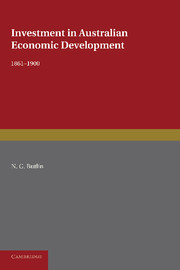Book contents
- Frontmatter
- Contents
- LIST OF TABLES
- LIST OF TEXT-FIGURES
- LIST OF PLATES
- Preface
- PART A INTRODUCTION
- CHAPTER I THE CONDITIONS OF AUSTRALIAN ECONOMIC GROWTH
- PART B THE PRIVATE SECTOR
- PART C THE PUBLIC SECTOR
- PART D STRUCTURAL READJUSTMENT
- Appendix I Revision of N.S.W. Residential Investment 1905/06-1911/12
- Appendix II Australian Domestic Product, Investment and Foreign Borrowing, 1861-1938/39.
- Bibliography
- Index
CHAPTER I - THE CONDITIONS OF AUSTRALIAN ECONOMIC GROWTH
from PART A - INTRODUCTION
Published online by Cambridge University Press: 05 June 2016
- Frontmatter
- Contents
- LIST OF TABLES
- LIST OF TEXT-FIGURES
- LIST OF PLATES
- Preface
- PART A INTRODUCTION
- CHAPTER I THE CONDITIONS OF AUSTRALIAN ECONOMIC GROWTH
- PART B THE PRIVATE SECTOR
- PART C THE PUBLIC SECTOR
- PART D STRUCTURAL READJUSTMENT
- Appendix I Revision of N.S.W. Residential Investment 1905/06-1911/12
- Appendix II Australian Domestic Product, Investment and Foreign Borrowing, 1861-1938/39.
- Bibliography
- Index
Summary
THE CONTOURS OF AUSTRALIAN ECONOMIC GROWTH
Australian economic growth followed the classic pattern of successful development through the establishment of a highly productive rural economy and the progressive re-orientation towards industrial activity. The process was achieved, formally, by the transfer of predominantly British factors, labour and capital, from an ‘ old’ area of relatively high rents, low wage and low interest rates, their combination with the expanding local workforce, locally accumulated capital and new resources and the subsequent development of social and productive assets to enter into world trade and increasingly to meet local demands. In the middle of the nineteenth century, the critical problem facing the Australian colonies was an intense shortage of both social and productive capital equipment. The study of Australian investment and its implications for economic growth provides an opportunity to explore, with some possible application to more general cases, the conditions of transition from an undeveloped economy to a wealthy, if still immature, society. Indeed, in these circumstances, the identification of the special conditions of Australian success may be as important, for more general understanding, as the elucidation of familiar general processes.
In 1860, the Australian colonies made up a loosely connected group of economies. No stable society, no effective social order, no established pattern of settlement, no sustained utilisation of available new resources, no definite composition of economic activity or of foreign trade, no substantial capital equipment and no continuing national capital accumulation had been achieved. The original gaol, the pastoral expansion of the eighteen-thirties and the gold discoveries each had special contributions to make to later economic history of the nineteenth century. But it was not until 1860, approximately, that a process of economic growth, sustained, large-scale, and complex, was begun to bring the vast new resources of the Australian continent effectively under European control. Thirty years later, the foundations of an enduring western society had been established and the social and productive assets of a coherent, efficient economy and of a wealthy society installed. This transformation was a prodigious effort. It was the product of a rate of expansion paralleled only by the United States; and it depended on the allocation of an exceptional fraction of gross domestic product to capital formation.
- Type
- Chapter
- Information
- Publisher: Cambridge University PressPrint publication year: 2013
- 1
- Cited by



